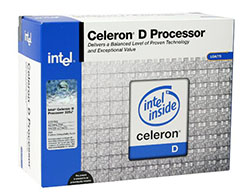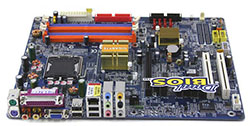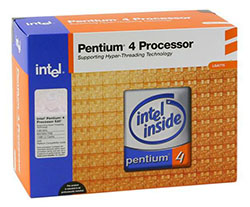Buyer's Guide - Entry Level to Mid-Range, March 2005
by Jarred Walton on March 15, 2005 1:30 PM EST- Posted in
- Guides
CPU and Motherboard: Intel
Unlike the AMD picture, where we have some real changes from our last Budget Guide, the Intel budget offerings are pretty much the same as last time. Considering the increased performance, lower power/heat requirements, and potential for 64-bit support that AMD offers, Intel doesn't really look that good. EM64T is only available starting at the $200+ processors, although we should start seeing some new Celeron D parts in Q2 that include EM64T. However, since we've switched from socket A in AMD-land, we'll ditch socket 478 in Intel-land as well. They're both being phased out rapidly these days, so we can't see advocating a purchase of a new system using a dying platform anymore.For a budget system, we're still looking primarily at Celeron D processors, as even the cheapest Pentium 4 chips will cost $150. (Certain socket 478 Pentium 4 chips are slightly cheaper, but again, we can't see recommending the 478 platform.) The motherboard chipset is a little harder to decide on, as you have 865 and 915 offerings to sort through. 865G/PE will cost less typically and allow you to use an AGP card, while 915G/P support PCI Express graphics cards. If you want integrated graphics, we'd go with an 865G motherboard, as the 915G boards are all rather expensive for a budget system. 865PE with a cheap AGP card would cost as much as most 915G boards (and generally perform better as well)! We're going to avoid the IGP options on socket 775 for this reason and go with 915P.
 |
 |
| Click images to enlarge. | |
Socket 775/T Motherboard: EPoX EP-5EPAJ 915P
Price: $82 shipped
Socket 775/T CPU: Intel Celeron D 325J 2.53 GHz 256K L2 Cache
Price: $84 shipped (Retail)
Total: $166
The best that we could come up with for a reasonable 775 system again uses an EPoX motherboard. Features are similar to the 8KDA3J that we used for our AMD system, only with an Intel chipset instead of an NVIDIA chipset. The hardware firewall is no longer present, of course, but gigabit Ethernet remains. Firewire support and HD audio are also missing. Remember that the 915 chipset is a PCI Express solution, so you will need a newer graphics card in order to use this motherboard. 915G motherboards will remove this requirement, but we suggest that you stick with the more expensive 915G as opposed to the 915GV/GL chipsets. See our alternative choice below.
Our processor of choice happens to be the cheapest (and slowest) option available for socket 775. It's not necessarily bad, of course, and for most tasks, it will perform well enough. Gaming is not one of those tasks, however, so if that's what you're after, go back to the AMD recommendations, please.
 |
 |
| Click images to enlarge. | |
Socket 775/T Motherboard Alternative: Gigabyte GA-8I915G Pro i915G
Price: $99 shipped
Socket 775/T CPU Alternative: Intel Pentium 4 520 2.8 GHz 1024K L2 Cache
Price: $152 shipped (Retail)
Total: $251
Our alternative upgrades to the base socket 775 recommendation uses a Gigabyte motherboard for its improved features. Among the additions are Azalia HD audio support and firewire ports, and we even get the integrated GMA-900 graphics as a bonus. Truth be told, you could use this motherboard as the "budget" option and skip the requirement for an add-in graphics card. The 915G and 915P chipsets are otherwise identical, so having the VGA port doesn't hurt, even if you never use it. The one area where the Gigabyte board may fall a little short is in overclocking support. If that's a real concern, the Abit AG8 is probably the next step up, but prices increase rapidly.
Our upgraded processor choice for Intel is once again their cheapest offering for socket 775; only this time, we've eliminated the Celeron from contention. That leaves us with the Pentium 4 520J, and the price is unchanged from our last budget Guide. At 2.8 GHz, the Pentium 4 is typically slower than any of the Athlon 64 processors. Of course, Intel still does a little better in a few applications like video encoding, provided that they have proper optimizations for the architecture. This is the bare minimum Intel P4 system with PCI Express support, though, and most people will be satisfied with the performance.










59 Comments
View All Comments
JarredWalton - Wednesday, March 16, 2005 - link
38 - I changed to the 9550 after the earlier corrections, as I had a 9600SE initially. I'll fix the text to suggest the purchase of a fanless 9550 and make the 9600 reference more appropriate. Thanks.doganti - Wednesday, March 16, 2005 - link
The article reads:"AGP Graphics Recommendation:MSI Radeon 9550 128MB DDR 128-bit, 250/400 GPU/RAM clock (bulk/OEM)
..
There isn't a whole lot to differentiate the 9550 cards from one another, as they are all fanless.."
I have Asus A9550 GE - Radeon 9550,128MB DDR,128 Bit and it has a fan (which has turned bad=noisy in a month).
Thus, also this is not clear: ".... The Radeon 9600 (without the SE) is also a decent alternative that will only cost an extra $15, and with it, you bump the memory bus up to 128-bits."
JarredWalton - Wednesday, March 16, 2005 - link
31 - If you can afford the bump to Athlon 64 3000+, the MSI RS480M2-IL would definitely be my pick for a board with IGP. Unfortunately, that adds $75 for the CPU upgrade (relative to the Sempron 2600+), but it also improves performance a decent amount. The ATI Xpress 200 is currently the best (BY FAR!) IGP on the market. It gives you S-VIDEO as well as VGA out. Too bad it doesn't have a DVI port as well. :)If that's too much... well, there are a lot of NF2 IGP boards for under $70. The NF2 is probably the better IGP between that and the K8M800 chipset, but the socket 754 CPUs are generally faster. With the price differences between platforms, I'd probably shoot for the Sempron 3000+ on socket A if you go for that platform. (The Barton core is simply the better choice, IMO.) That would compare relatively well with the socket 754 Sempron 2800+ - win some, lose some in benchmarks. I guess it really doesn't matter *too* much if you're not looking for the best performance possible. $150 gets you a decent CPU and mobo for socket A of socket 754, while on socket 939 it only gets you a CPU.
----------------------------------------
For the other comments, the PDP isn't great for overclocking, but with a price now at $130 and 2-3-2-5 timings, I'd take the GB of RAM even at stock speeds. If it OCs decently, great. If it doesn't, you should still be fine at stock speeds.
The Hitachi drives may not have the best RMA process, but let's be honest: if you need to use the RMA on *any* hard drive, you'll be very unhappy. I don't think any of the 7200 drives would fail in most systems if they're the only HDD. Just don't put a bunch of them next to each other without proper cooling. At $60 for an 80GB drive, I would probably make backups and if the HDD failed I'd buy a new drive while I RMA'ed the old one. That's just me, though.
Finally, the motherboard area is just such a hard one to give *one* recommendation. Even a recommendation and alternative doesn't really do justice to the available parts. There are so many good boards these days that are all within close proximity in terms of price. If I were looking for socket 939 boards, I'd go as follows in terms of chipsets:
nForce 4 (preferrably not 4X, but any are good)
ATI Xpress 200 (not many available yet)
VIA K8T890
nForce 3 Ultra
VIA K8T800 Pro
ALi/ULi/SiS whatever
I'd go with the top three over the bottom three by a pretty significant margin. K8T800 Pro is now about 9 months old, IIRC. It's still okay, but I wouldn't look to save money by going that route. The nF3 is the same, but it's the better chipset for AGP, IMO. Given the price the K8T800 Pro usually wins out, however.
Messudieh - Wednesday, March 16, 2005 - link
I have the PDP RAM that you mentioned in your review, and I can honestly say that the ability to overclock any one set is sort of a crap shoot it seems. It sounds to me like they use a couple of different types of chips (some being the TCCD chips, while others Infineon) that can all run at the stated 2-3-2-5 speeds, at 2.6 volts in my case.I think I got a set of something other than TCCDs, because I can't overclock them past about 210 with ANY timings on a DFI NF4 ultra-D with a watercooled 939 3000 and keep it stable, even at 3.1 or 3.2 volts.
Like I said...it's a crap shoot; some people get lucky, and others don't. I'm getting this RAM:
http://www.newegg.com/app/ViewProductDesc.asp?desc...
And selling my Patriot to my friend, who doesn't overclock.
Jep4444 - Wednesday, March 16, 2005 - link
oops forgot that the MSI board is 939, either way the Winchester based Athlons are good overclockers anywaysBPB - Wednesday, March 16, 2005 - link
"Semprons K8s are typically very good overclockers so i wouldn't rule out that noones is going to overclock them in a budget machine"Do they make socket 939 Semrpons?
As for me, I went with the MSI ATi based board and am very happy. Put in a 939 3000+, and a Hitachi 80GB SATA II drive. The Hitachi was only $62 at ZipZoonFly. So for a tad more got SATA II (I know, no SATA II controller on this board, but at least the drive has it). The board also has slightly better than average onboard sound, going with the Realtek ALC658C, not the 650 or 655 found in other boards.
Eventually will put a capture card and mid-level video card. I now have a pretty fast system for the price. Oh, went with the 1GB PDP Patriot memory in the article. No problems to report with anything. Very, very happy with the setup.
Jep4444 - Wednesday, March 16, 2005 - link
"The only downside is that the MSI's uATX board doesn't have any OC capability, but who's looking for that in a budget-minded PC?"Semprons K8s are typically very good overclockers so i wouldn't rule out that noones is going to overclock them in a budget machine
razor2025 - Wednesday, March 16, 2005 - link
Why no mention of MSI Neo4-F? It's less than the Chaintech @ $95 shipped at ZZF and it has same PCB as the Neo4 Platinum. That's much better choice over the Chaintech if you're going NF4 route. I also belive that the Xpress200 chipset should've been included as alternative. It's the perfect board for budget PC and it'll allow LOTS of options for upgrades later down the road. The only downside is that the MSI's uATX board doesn't have any OC capability, but who's looking for that in a budget-minded PC?If AMD can get a Sempron out for Socket 939 for around $100... then we can have some really nice sub $400-500 PC with lots of options for upgrade.
jxtramd - Wednesday, March 16, 2005 - link
OK I've followed the budget guide now for about 6 months and I'm on the cusp of a decision about building an AMD IGP based system. The choices are either from the Jan 05 guide with the MSI (or other) MB with the nForce2 IGP or the Mar 05 Chaintech (or other) MB with the VIA K8M800 IGP. Both systems with an appropiate Sempron 2600 and 512 memory. Between the two which combo gives the better graphics performance? I'm not interested in gaming. Just a basic system with the ability to capture video and watch DVD's as examples. A IGP system fits my budget - any comments?Jep4444 - Wednesday, March 16, 2005 - link
A little look on newegg has shown that every 32-bit 6200TC has 16MB of onboard RAM, oddly enough their are NO 32MB 6200TCs on newegg at all(whether 32 or 64-bit)also i looked at the review you guys posted on the 6200TC and here's a little bit of info on the 16MB and 32MB parts
"With NVIDIA talking about bringing the new 32MB 64-bit TurboCache part out at $99 and the 16MB 32-bit part out at $79"